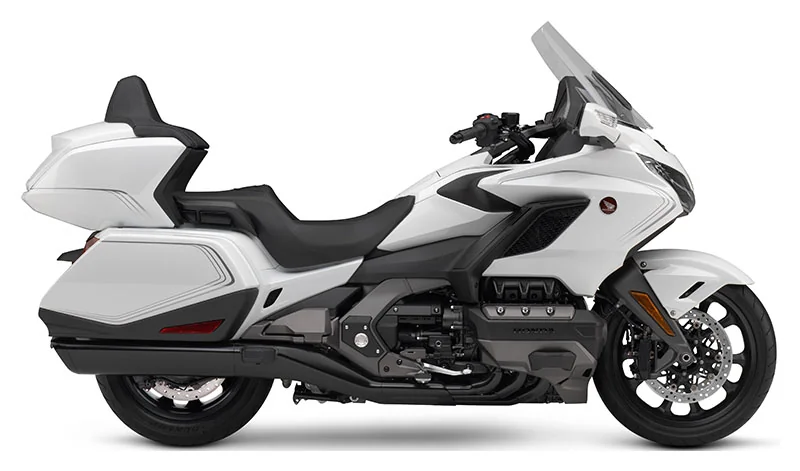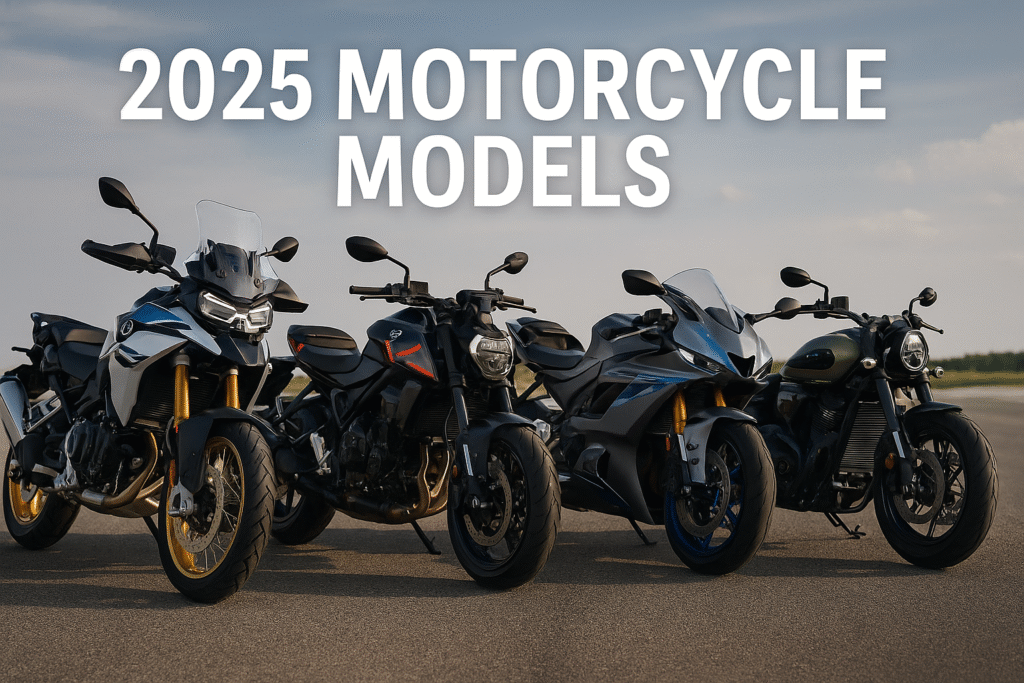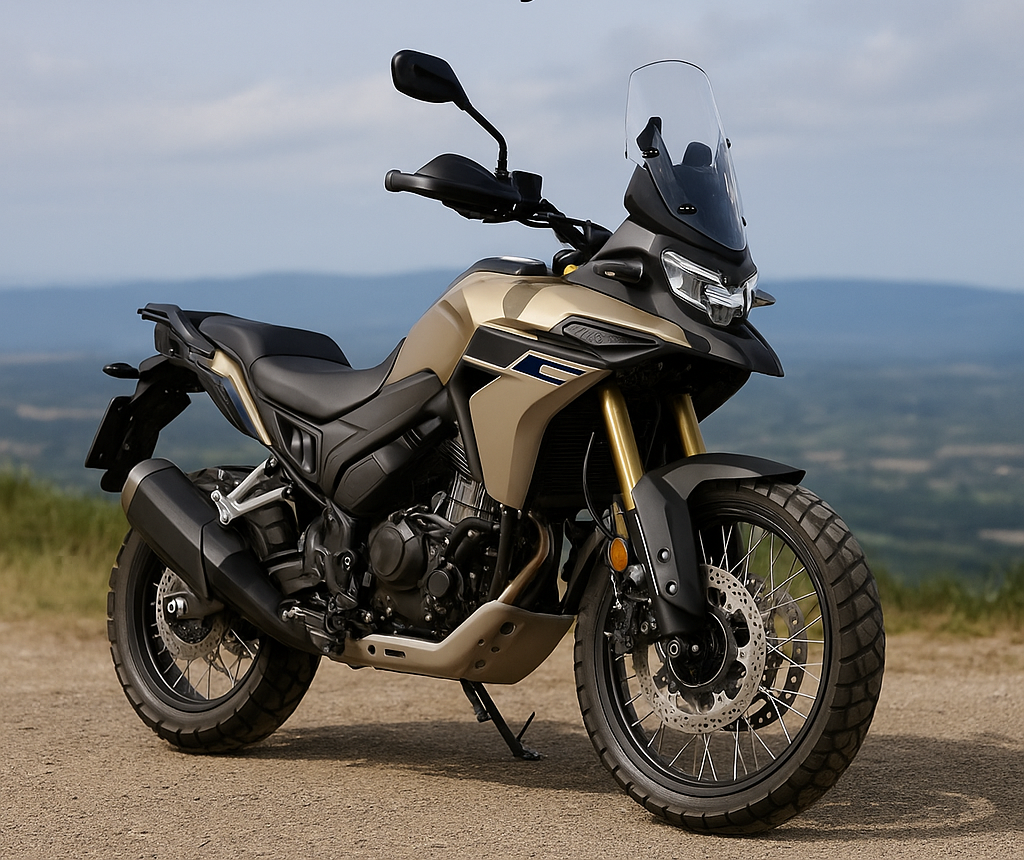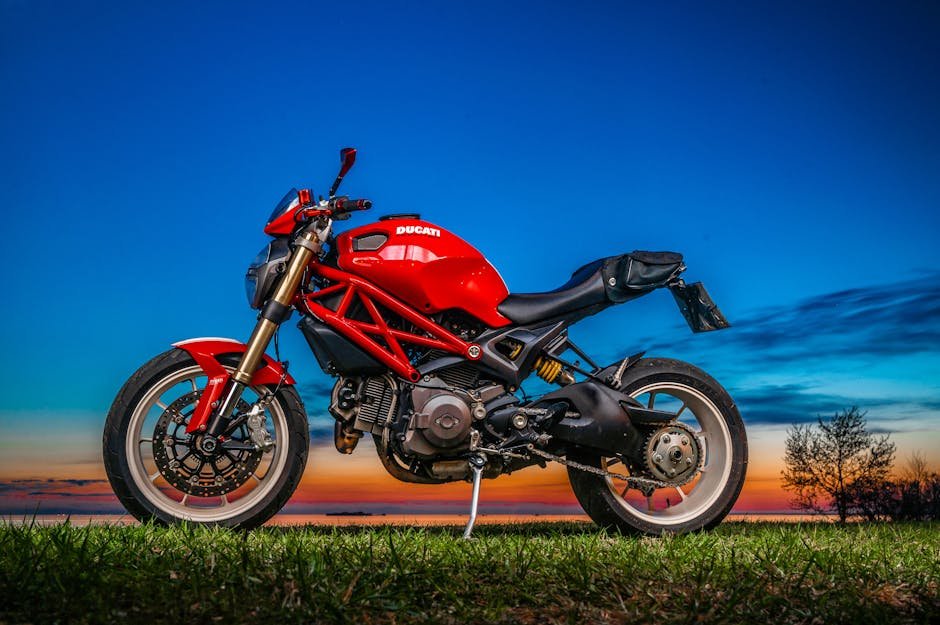Table of Contents
Golden Anniversary Updates and Heritage
Honda marks 50 years of Gold Wing production with special 50th Anniversary editions of the 2025 GL1800. The changes are subtle but meaningful. Exclusive color schemes – such as Bordeaux Red Metallic with gold badging and an Eternal Gold trim – pay homage to the Gold Wing’s lineage. A commemorative badge in front of the seat and a startup screen reading “Since 1975” highlight the bike’s heritage. Buyers also receive a coffee-table history book and a 1:12 scale model showing a 1975 GL1000 alongside the 2025 GL, underscoring how far the Wing has come. Apart from aesthetics, Honda made a notable tech change: they removed the built-in navigation system, instead relying on wireless Apple CarPlay and Android Auto for maps. This is a welcome update as the Honda Gold Wing finally embraces smartphone-based navigation, a nod to modern touring needs.
Despite the anniversary fanfare, the core bike remains largely the same as recent models – which is not a bad thing. The Gold Wing’s legacy of innovation is intact. It still features the distinctive flat-six 1833cc engine, shaft drive, and hallmark comfort and reliability that defined its touring dominance since 1975. Honda’s celebration events this year have highlighted the model’s evolution – from the original GL1000 “grand tourer” with 80 horsepower to today’s high-tech GL1800 delivering roughly 120 horsepower in ultimate luxury.
Engine, Power and Performance
At the heart of the 2025 Gold Wing is the familiar 1,833 cc horizontally opposed six-cylinder engine. It produces approximately 120 hp @ 5,500 rpm and a stump-pulling 126 lb-ft of torque @ 4,500 rpm. This flat-six is renowned for its turbine-like smoothness and massive low-end torque, which make two-up touring and steep mountain passes effortless. For 2025, there are no mechanical changes, but none were needed – the Gold Wing already had one of the most refined powertrains on two wheels. Acceleration is deceptively quick for an 850+ lb motorcycle; the Wing can hustle to triple-digit speeds smoothly, underlining why the model earned a reputation as a “couch with a rocket engine.”
Riders have a choice between a slick 6-speed manual with slipper clutch or Honda’s advanced 7-speed Dual Clutch Transmission (DCT). On our test ride, the DCT proved exceptionally convenient for touring. In Tour mode, gear shifts were seamless and unobtrusive, letting the engine’s wave of torque do the work. Engaging Sport mode woke up more aggressive shifting and throttle response, though even then the DCT remained smooth and intuitive. Traditionalists can still opt for the manual transmission (complete with electric reverse gear), but given the Gold Wing’s touring mission, the DCT truly shines by eliminating shift fatigue on long rides.
Cruising at 70–80 mph, the Gold Wing’s engine barely breaks a sweat – turning low RPM with minimal vibration. Roll-on power is immediate; just a twist of the throttle in top gear is enough to surge past traffic, thanks to that prodigious torque. Honda’s claimed fuel economy is around 42 MPG, which combined with the 5.5-gallon fuel tank gives a comfortable range of over 200 miles between fill-ups – critical for long-distance touring.
Chassis, Suspension and Handling
One might expect a nearly 840-pound touring bike to wallow in corners, but the Gold Wing defies those notions with remarkably composed handling. Credit goes to the innovative double-wishbone front suspension and a well-balanced chassis. The double-wishbone design (unique in the motorcycle world) separates steering and suspension forces, reducing fork dive under braking and giving the Gold Wing a planted feel. Over rough pavement and highway bumps, the front end stays steady, filtering out harsh jolts that would upset a conventional fork. As a result, our ride felt “placid” and stable, even when hustling this big machine through sweepers.
At the rear, a Pro-Link monoshock with electronically adjustable preload allows riders to dial in suspension for solo or two-up riding on the fly. The 2025 model does lack modern semi-active suspension – a feature found on some competitors – which Honda was surprisingly conservative about not adding for the anniversary. Still, the Wing’s suspension settings find a good compromise between comfort and control. On interstates, it soaks up expansion joints with luxury-car smoothness, yet in tighter turns it offers enough support to avoid bottoming or excessive wallow. We confidently scraped the Gold Wing’s pegs on winding backroads, impressed by how well it hid its weight. As one tester noted, “the GL can hold its own while delivering all the luxury it’s known for,” even if cornering clearance remains a limiting factor.
Braking is handled by dual 320mm front rotors with 6-piston calipers and a 316mm rear disc, linked with ABS. The brakes are powerful and fade-free – crucial on a bike this heavy. Honda’s combined ABS system modulates front and rear braking force to keep stops drama-free. During one spirited downhill section, the big Wing shed speed confidently; the massive six-pot calipers up front provide strong bite, and the linked system helps keep the bike balanced under hard braking. In fact, stopping distances approach that of some sport-tourers, a testament to Honda’s brake engineering.
Comfort, Tech and Features
Where the Gold Wing truly excels is comfort over long distances. The rider and passenger accommodations remain top-notch. The seat is broad and supportive, and for 2025 the foam shape was tweaked slightly for a “neutral” hip position that reduces fatigue. Heated grips and seats (on Tour models) kept us cozy during a cool morning ride. The electric windscreen adjusts over a 4-inch range, and in its highest position it creates an incredibly quiet bubble – we even had a hands-free phone call at 70 mph and the other party didn’t realize we were on a bike. Lowering the screen invites a pleasant breeze on hot days. Aerodynamics were refined in the 2018 redesign and remain effective: wind protection is excellent for rider and pillion, with minimal buffeting around the helmet.
The Gold Wing comes loaded with tech. The 7-inch TFT display and infotainment system include navigation (now via CarPlay/Android Auto as mentioned), Bluetooth connectivity, and customizable ride modes (Tour, Sport, Econ, Rain). Cruise control is standard (as it has been since the mid-’80s on the Gold Wing), though an adaptive cruise control was notably absent – a feature some expected Honda to add for this anniversary edition. The bike also features an effective traction control system and integrated ABS for safety in adverse conditions.
Storage capacity on the Tour models (with trunk) totals over 110 liters across the saddlebags and top case, easily swallowing luggage for two. On the standard “bagger” Gold Wing (no trunk), capacity is less, but many riders in that segment prioritize style over maximum storage. One neat touch on the 50th Anniversary edition: those who purchase get Gold Wing-branded luggage liners for the hard cases and trunk, making it easy to haul belongings into a hotel at the end of a long day’s ride.
Perhaps the only tech omission glaring in 2025 is the lack of radar-based adaptive cruise control and blind-spot monitoring – features now found on some rival touring bikes (like BMW’s R 1300 RT and select Ducati/Indian models). Honda chose not to incorporate these yet. As a result, the Wing feels a step behind in rider aids. However, the fundamentals – comfort, wind protection, smooth power, and rock-solid stability – are so well executed that the Gold Wing still feels every bit the luxurious mile-muncher it has always been.
Verdict: Reigning Supreme at 50?
After riding the 2025 Gold Wing 50th Anniversary Edition through highways, backroads, and even a few racetrack laps for fun, we’re happy to report that the Gold Wing remains the king of touring. The 50th Anniversary model doesn’t revolutionize the formula – instead, it refines and commemorates it. The flat-six engine is as velvety and torque-rich as ever, the handling defies the bike’s size, and the comfort and build quality set the standard for long-distance touring.
Honda’s updates for the anniversary are mostly cosmetic, but they serve to remind us of the Gold Wing’s storied legacy. And crucially, the core platform that was heavily overhauled in 2018 is aging gracefully. By shedding weight back then and adding features like DCT, the modern Gold Wing appeals to a broader range of riders, including a somewhat younger demographic Honda is keen to attract. The only real criticisms are the lack of cutting-edge assists (no radar cruise) and the high cost – MSRP ranges from $25,200 for the base model to $33,500 for the Airbag DCT Tour edition, putting it at the top of the class in price. But you do get what you pay for: an icon of comfort and reliability that can easily surpass 100,000 miles of two-wheeled adventures.
In sum, the 2025 Gold Wing 50th Anniversary remains a gold standard. It may carry a hefty price and a few missing high-tech frills, but as an overall touring package it’s nearly untouchable. After 50 years, the Wing still wears the crown – and it wears it with the effortless grace and dignity that have always defined Honda’s flagship touring machine. The King of Touring lives on, long live the Wing!




